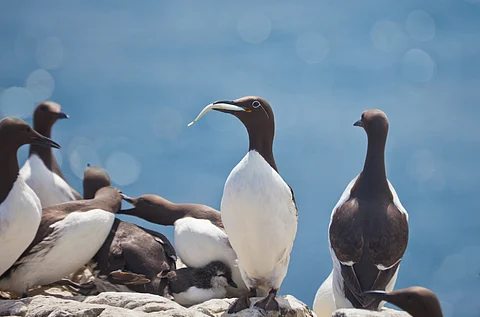

An extreme marine heatwave linked to climate change devastated Alaska’s common murre (Uria aalge) population, wiping out nearly four million seabirds — about half of their global numbers — over a three-year period. This marks the largest documented wildlife mortality event in modern history, according to a study recently published in the journal Science.
The study, conducted by the United States’ Fish and Wildlife Service’s Alaska Maritime National Wildlife Refuge in collaboration with partners, presented evidence of the mass deaths from a major marine heatwave that occurred between 2014 and 2016.
Researchers found that the murre population in 13 monitored colonies plummeted by 52-78 per cent during this period. “No evidence of recovery has yet been observed, suggesting that these ecosystems may no longer support historic numbers of seabird top predators,” the scientists reported.
Rising temperatures due to climate change can cause swift, intense and long-lasting impacts, with potentially permanent changes to ecosystems, the study warned.
Common murres are long-lived diving seabirds that inhabit temperate and subarctic marine ecosystems in the Northern Hemisphere. They feed on small schooling fish, juvenile predatory fish and krill, diving as deep as 200 metres to forage.
Before the heatwave, Alaska’s murre population was estimated at eight million birds, representing 25 per cent of the global total, the authors of the report noted. Around 80 per cent of these birds bred in colonies stretching across the Gulf of Alaska and the Eastern Bering Sea.
The scientists studied long-term data from the 13 monitored sites, comparing colony sizes before and after the heatwave. Pre-heatwave, the eight monitored colonies in the Gulf of Alaska had about 1.12 million birds, or approximately 32 per cent of the 3.48 million birds in the region at the time.
“In the Eastern Bering Sea, approximately 881,000 breeding birds occupied the five monitored colonies, or about 31 per cent of the 2.84 million birds in this large marine ecosystem, before the heatwave,” the study noted.
Approximately 1.28 million murres died at these monitored colonies alone and extrapolated data suggests a total loss of around four million birds across all known colonies in the region, the researchers found.
Seven years after the heatwave event, about half to three-quarters of the common murres have not returned to the studied colonies. While some murres that skipped breeding during the heatwave have since reappeared, many remain absent.
The researchers concluded that a sudden decline in the quality, quantity and accessibility of forage fish led to mass starvation among the bird population. “To our knowledge, this is the largest mortality event of any wildlife species reported during the modern era,” they concluded.
It is possible that the birds were already stressed pre-heatwave, the paper noted. “Five of eight modelled colonies showed evidence of decline [in numbers] pre-heatwave,” it said.
The impact of the heatwave extended beyond the common murres. In the Gulf of Alaska, Pacific cod (Gadus macrocephalus) populations declined by nearly 80 per cent between 2013 and 2017, prompting fishery closures.
Meanwhile, humpback whale (Megaptera novaeangliae) numbers in the North Pacific, which had been recovering post-whaling, dropped by 20 per cent during the heatwave, with current populations constrained by climate-induced food shortages.
“After a steady post-whaling recovery of humpback whales (Megaptera novaeangliae) in the North Pacific to a peak in 2013, numbers declined by 20 per cent during the 2014-2016 northeast Pacific marine heatwave and now appear to be constrained by climate-induced food limitation, that is, reduced carrying capacity,” it said.
The scientists further warned that the rapid and long-term decline of a widespread top predator to nearly half its previous population size could signal a new threshold of ecological response to global warming.